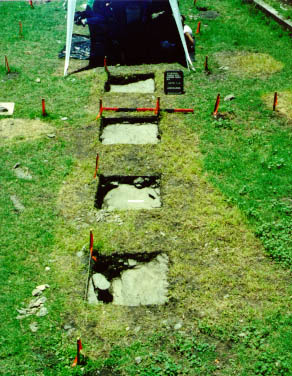| The image below shows an east-west transect in area 1 on the site map, off the north side of the old School house (now the Rectory). The bedrock underlying this site can be seen in each of these excavation units. These units typically ended 12 to 16 inches below the grass surface, where the excavator uncovered the top of an outcrop of solid bedrock called Harpers Ferry shale. This shale appears to contain concentrations of iron at some locations within the site, which would distort magnetic compass readings in those limited areas. To overcome this problem, we used geometric calculations to expand our transect grid outward from central measurements which had been obtained using both a surveyor's transit and a compass.

The soil layer surrounding the School house was rather shallow in many places in area 1, and deeper on down-slopes in areas 2 and 3 on the site map. We found that the grounds surrounding the School house had been disturbed over time, so that almost all excavation units contained artifacts which had been jumbled, with some older artifacts higher in the soil than more recent ones. There are three general interpretations of this disturbance of the soil layers and the related processes by which soil and artifacts become deposited on a site: (1) the artifacts were deposited into the soil on-site, and the soil and artifacts were later mixed and disturbed by landscaping and construction work on the grounds; (2) portions of the soil and artifacts may have washed onto the School house grounds from neighboring sites upslope during heavy rains; and (3) the soil and artifacts may have been hauled onto portions of the School house site, for use as fill, from neighboring sites on various occasions. One, two or all three of these depositional processes may have occurred over time. The extensive amount of landscaping and construction work at the site over time provides evidence supporting the first process. If the second or third processes occurred, areas 1-3 may have received household artifacts which most likely originated on nearby residential sites, while area 4 contains some ceramic and iron slag which may have come from more commercial sites elsewhere within Harpers Ferry. |
